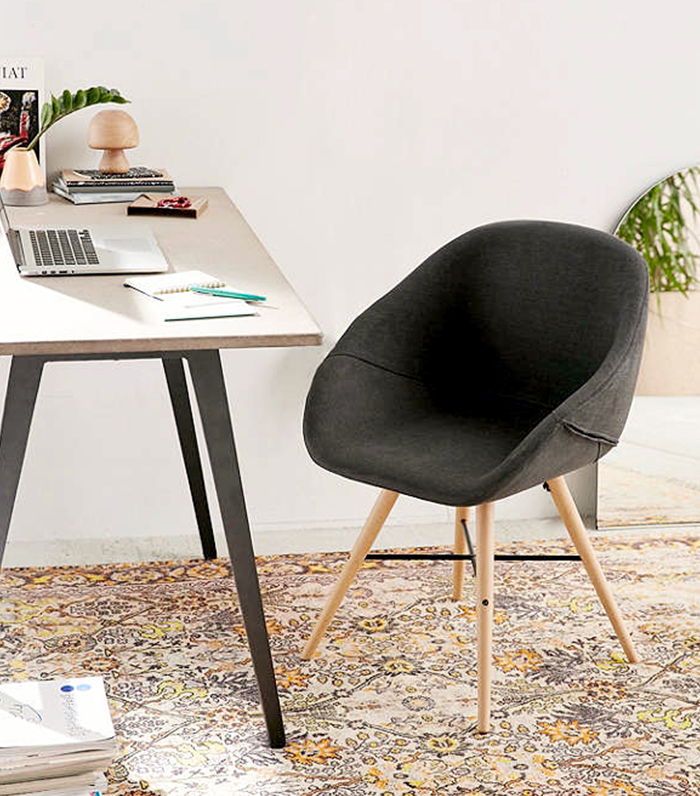Here's How to Improve Your Posture So You'll Never Have Back Issues

Maya Allen
You’re slouching as you read this sentence, aren’t you? No judgment—whether we’re conscious of it or not, we all do it. Even if you do have your perfect posture moments, the simple fact that our muscles tire easily when they stay in one position (it’s true—our bodies are built to be in motion) means a slump is never far behind. However, you don’t need to invest in a posture harness or enlist someone to poke you in the lower back every time you start to sink down in your chair.
You just have to be aware of simple habits you can practice throughout the day to improve your posture. We talked to Allison Stringer, a physical therapist at Proex Physical Therapy, an affiliate of Professional Physical Therapy, and Mark El-Hayek, head chiropractor and owner of Spine and Posture Care based in Australia, to share their recommendations on improving posture.
"Sitting with poor posture causes increased stress and force on the neck and back," explains Stringer. "The average head weighs between 10 and 11 pounds and when you sit up straight the weight of your head is absorbed by your spine. When you sit in a slumped posture your neck and back muscles now need to hold your head up, the neck moves into extension and your jaw jets forward. This can cause headaches, jaw pain, middle and lower back pain."
To keep this from becoming your new normal, take note of a few simple tricks you can do throughout the day, and soon you’ll be sitting (and standing) tall.
Keep reading for how to improve posture—walking with a book on your head is not one of them.
Stretch

Stretching out your muscles is a good way to avoid unnecessary strain, a common cause of slouching. Doing a few cat and cow stretches in the morning helps to wake up your muscles after sleep and brings your back alignment top of mind right away.
You can also try a set of wall angels. Stand with the back side of your body against a wall, legs hip-distance apart, arms extended in 90-degree angles on either side (like a goal post). Then, slowly raise and lower your arms, maintaining contact with the wall. This opens and lengthens the muscles in the front of your body.
Shoulder shrugs and head tilts are easy movements to work in throughout the day that will also loosen you up. Another a good idea? Standing. Get up and go for a walk (even just a lap around the office) every 30 to 60 minutes to keep your muscles happy.
Stringer suggests stretching for 30 seconds three times a day. She's an advocate of the below neck, chest, and hip stretches.
- Neck: Gently forward bend neck, lean ear to the left, turn head to the right. Repeat in the opposite direction.
- Chest: Using a foam roll, lie on your back, along the length of the foam roll. (Support your head if you cannot rest it on the foam roll without causing your neck to be extended.) Allow your arms to extend out, and rest on the floor with the palms facing up. Gradually slide your hands up while keeping the back of your forearms and hands on the floor, until you feel a stretch in the chest.
- Hips: Kneeling on one knee, with the opposite foot on the floor, squeeze buttocks, straightening the lower back.
Upgrade Your Chair

Adding a lumbar support pillow to your chair supports your spine and forces your back into the correct position the second you sit down. (In a pinch, a small pillow or rolled-up towel will help decrease posture stress, too.) Better yet, buy an exercise ball. Sitting on a balance ball like the ones you use at the gym encourages proper posture and maintains your lumbar curves. Sitting tall on an exercise ball also strengthens your core, which helps your posture in the long-term.
Uncross Your Legs

Sadly, you’re probably sitting in your chair all wrong. The correct way requires you to place both feet flat on the ground, weight distributed evenly. Crossing your legs is an unbalanced posture. Plus, it often causes you to lean, which is another unbalanced posture that puts undue stress on one side of your body. If your legs are too short to be able to comfortably plant both feet on the ground, prop something under your feet. Try using a laptop stand or an old boot box.
Adjust Your Workspace

Stringer points out the importance of ensuring your work station is adjusted to you. "Sit with both feet flat on the floor. Be sure to create an angle between your trunk and hips so that your knees are lower than your hips (120 degrees). Support the lower back with a small towel or cushion. And the top of the computer screen should always be at eye height." If you have one available, she also suggests using a standing desk for part of the day.
If you have to outstretch your arms to reach your keyboard or tilt your head to view your computer, your workspace needs some revamping. Adjust your positioning so that arms are flexed, not extended, and wrists are straight when typing. Aim for a 75- to 90-degree angle at your elbows.
Also, your monitor should be level with your natural eye line. Add a riser or a sturdy book underneath your computer to lift the monitor up to your eye level. Are you leaning forward to view your screen? Time to get your eyes examined. Your out-of-date prescription could be causing you to slouch or lean forward.
Practice Active Posture

It's all about standing tall. "Use muscles to sit unsupported in an S shape vs. C shape. Once an hour, stand up, walk to the water cooler, and drink an 8 oz. glass of water. On the half hour, squeeze shoulder blades together 10 times for 10 seconds," says Stringer.
El-Hayek also notes the importance of staying active throughout the day and not chained to your desk. "Studies show that the average office worker only stands for 73 minutes in a 24 hour period. While sitting for long periods can be harmful to the body, it's not sitting that's the problem. It's the fact that we maintain our body in a static position for an extended period of time. This means that prolonged standing can be just as bad."
El-Hayek suggests standing up and moving from a seated position every 20 minutes. "Even getting up for 10 seconds before going back to sitting can be beneficial. This can be hard, especially when you're focused on a task—so the best way to accomplish this is by setting an alarm as a reminder or only keeping a small glass of water on your desk, which forces you to stand up to refill it more often," he says.
On the contrary, you should not force your posture to stay upright all day. One of the most common questions El-Hayek gets from his patients is "Should I try to force my back to stay up?" Realistically, this position is hard to maintain throughout the day.
"Forcing your body to stay upright, in fact, ends up causing more harm than good. It causes your muscles to stay contracted over longer periods of time leading to them becoming achy, sore, and potentially leading to long-term pain." He believes it's important to stay aware of your posture, but you’re better off correcting it and forgetting about it rather than constantly forcing it to stay in an upright position.
Change Your Accessories

High heels and thick-soled shoes alter your body’s center of gravity and throw off your alignment, so opt for flats or low heels whenever possible. Also, carrying around heavy purses increases strain and negatively impacts your posture. Clean your bag out regularly to avoid toting around heavy objects you don’t need and switch arms frequently to prevent stress and fatigue.
Exercise

Implement a steady exercise routine three to four times a week to improve your posture. Stringer suggests things like standing rows, planks, overhead presses, and squats that focus on your back area.
Up next, hear from a wellness editor on five amazing things that happen when you stand with good posture.
This post was originally published at an earlier date and has since been updated.
This article is provided for informational purposes only and is not intended to be used in the place of advice of your physician or other medical professionals. You should always consult with your doctor or healthcare provider first with any health-related questions.

Jane Birkin
Who are your 5 favorite people to follow on Instagram?@somethingnavy @phoebejtonkin @jenavieve @beautyisboring_ @ctilburymakeup
What's the beauty essential you can’t live without?Concealer
What's your desert island album?Hall Oates Voices
What's your favorite Byrdie.com story? 7 Beauty Secrets To Steal From India, The Middle East, and Beyond See More